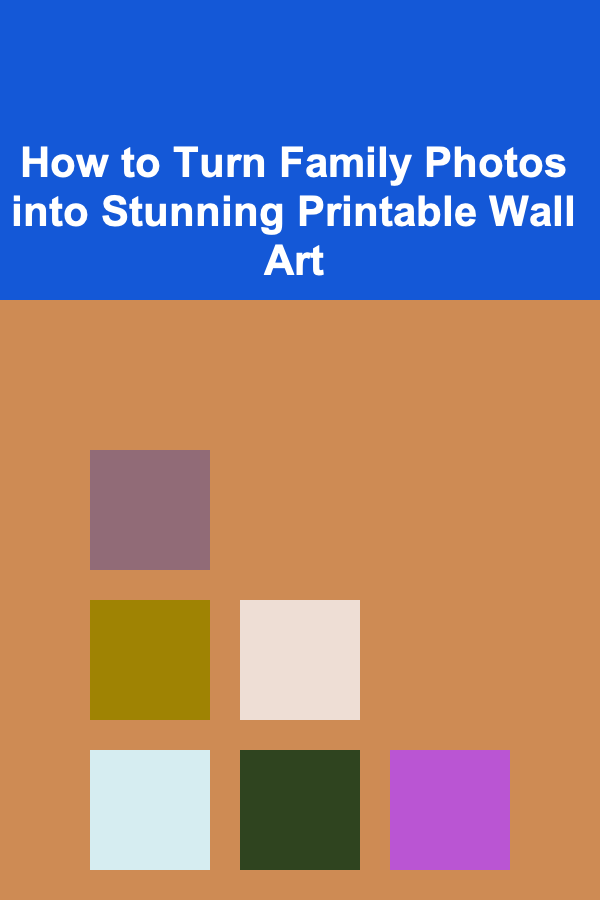
How to Turn Family Photos into Stunning Printable Wall Art
ebook include PDF & Audio bundle (Micro Guide)
$12.99$5.99
Limited Time Offer! Order within the next:

Turning family photos into stunning wall art is a creative and meaningful way to personalize your home. Family photographs capture moments of joy, love, and togetherness, and transforming these precious memories into beautiful prints can add warmth, personality, and charm to any space. Whether you want to create a gallery wall, a statement piece, or a cozy corner filled with personal images, the process of turning family photos into artwork is both fulfilling and rewarding.
In this guide, we'll explore how to turn your cherished family photographs into breathtaking wall art. From selecting the right photos to choosing the ideal printing options, framing ideas, and arranging your photos for the perfect display, we'll cover everything you need to know to elevate your home décor with personal, meaningful art.
Step 1: Selecting the Right Photos
The first and most important step in turning family photos into printable wall art is selecting the right photographs. These images will serve as the foundation for your artwork, so it's essential to choose the ones that will not only look great on your walls but also evoke the emotions and memories you wish to capture.
Consider the Mood and Theme
- Emotional Connection: Choose photos that hold sentimental value, whether it's a candid family moment, a special occasion, or a snapshot of an everyday moment that makes you smile. The emotional connection you have to the photo will make the art even more meaningful.
- Consistency: If you're planning to create a gallery wall or a series of prints, try to select photos that have a consistent tone, color palette, or subject matter. For example, you could choose black-and-white photos for a classic look or photos from a specific family vacation for a themed collection.
- Variety: Mix up the types of photos you use. Some could be close-ups, while others might be wider shots. Including a variety of photo styles adds visual interest and depth to the final display.
Image Quality
Ensure that the photos you select are high-quality images. Blurry or pixelated photos will not translate well into large prints. Ideally, aim for images with a high resolution (at least 300 DPI for prints) to ensure that they look crisp and professional when blown up.
Step 2: Editing and Enhancing Your Photos
Once you've selected your photos, it's time to enhance and edit them. Photo editing can make a significant difference in the final product, turning a good image into a great one.
Basic Edits
- Crop and Align: Cropping the photo to highlight the main subject can create a more polished look. Also, straighten any tilted photos for a balanced composition.
- Adjust Brightness and Contrast: Increase the brightness or contrast of an image to make it pop. These adjustments help ensure that your photo has the right amount of detail, particularly if it will be printed in a larger size.
- Sharpness: If the photo is slightly out of focus, try to enhance its sharpness. Be careful, though---over-sharpening can create unnatural edges.
Creative Edits
- Black and White: Converting your photos to black and white can create a timeless, classic look that works well in almost any space. Black-and-white photos often highlight the emotional depth of the moment captured in the image.
- Filters and Effects: Use subtle filters or effects to give the image a unique feel. You could opt for a vintage or sepia tone for a nostalgic vibe, or a more contemporary look with cool or warm tones.
- Retouching: If there are any distracting elements in the background or minor imperfections, consider retouching the image. This step is particularly important if the photo will be enlarged.
Step 3: Choosing the Right Printing Options
Now that your photos are ready, it's time to think about how to print them. There are several factors to consider when selecting the right printing options, including paper type, print size, and print finish.
Paper Type
The type of paper you choose will affect the texture and quality of your print. Common options include:
- Glossy Paper: Glossy prints have a shiny, reflective surface that enhances color vibrancy and sharpness. However, they can show fingerprints more easily and may glare in certain lighting.
- Matte Paper: Matte paper has a non-reflective finish, giving prints a soft, smooth look. It's perfect for creating an elegant, understated look. Matte prints tend to have a more muted, vintage feel.
- Canvas: Printing on canvas gives your photo an artistic, textured appearance. Canvas prints are typically framed, which adds a bit of depth and sophistication to your artwork.
- Fine Art Paper: If you're looking for a high-end, professional look, fine art paper is the best option. It's made from cotton or other high-quality materials, and it often has a textured surface that enhances the overall appearance of the print.
Print Size
The size of your print depends on where you plan to hang it and the space you want it to occupy. Larger prints can make a bold statement, while smaller ones can create a more subtle, intimate display.
- Small Prints: Ideal for a minimalist look, small prints work well in bedrooms, hallways, or as part of a gallery wall.
- Medium Prints: Medium-sized prints are versatile and work in almost any room, especially living rooms and offices. They can stand alone or be grouped with other prints.
- Large Prints: Large wall art can serve as the focal point of a room, adding drama and personality to your décor. They work best in spacious areas, such as above a sofa or as a central piece in a dining room.
Print Finish
The finish of your print determines its overall look:
- Glossy Finish: Adds shine and vibrancy, making colors appear more vivid.
- Matte Finish: Offers a soft, subdued look, with less glare and a more classic aesthetic.
- Canvas: Adds texture and depth, making your photo resemble an oil painting.
- Metal Prints: A more modern option, metal prints provide a sleek, shiny surface that brings out vibrant colors.
Step 4: Framing Your Photos
Framing is a key element that can transform a simple family photo into stunning wall art. A well-chosen frame can enhance the overall look of your photo and tie it into the room's décor. When selecting a frame, consider the following:
Frame Style
- Classic Frames: Traditional frames with a wooden or metal finish can give your photo a timeless, elegant look.
- Modern Frames: Sleek, minimalist frames with clean lines are ideal for contemporary or minimalist interiors.
- Rustic Frames: Wood frames with a distressed finish can add a rustic charm to your photo, perfect for creating a cozy, farmhouse-style vibe.
Frame Size
The frame should complement the size of your print. It should not overwhelm the photo, but rather draw attention to it. Ensure that there's a small border around the photo to create a balanced effect.
Matting
Matting is the border around the photo within the frame. It adds depth and sophistication to your print. Choose a mat color that complements the photo's color scheme and the room's décor. White or off-white mats are popular, but you can experiment with different colors to create contrast.
Gallery Walls
If you're creating a gallery wall with multiple family photos, use matching frames or frames of similar style and color to create unity. Play with the arrangement of the frames on the floor before hanging them on the wall to ensure a balanced, visually appealing display.
Step 5: Arranging and Hanging Your Wall Art
The final step is arranging and hanging your framed family photos. Proper placement and arrangement can make a huge difference in how the artwork is perceived in the room.
Layout Ideas
- Grid Layout: Arrange your photos in a grid, with equal spacing between them. This symmetrical arrangement works well for a clean, orderly look.
- Gallery Wall: A gallery wall is a more eclectic option, where the photos are arranged in a less structured way. The frames can be of different sizes, creating a dynamic and personalized display.
- Statement Piece: If you have one large print, place it in a prominent position, such as above a mantel, sofa, or bed. A single large image can create a powerful focal point.
Hanging Tips
- Eye Level: For the best viewing experience, hang your artwork at eye level. If you have a large print, it can be slightly higher, but keep it within a comfortable viewing height.
- Spacing: Keep the spacing between frames consistent for a harmonious look. If you're unsure, leave about 2-4 inches between each frame.
- Use the Right Hardware: Ensure you use the correct hanging hardware for the weight and size of your frames. Picture hanging strips, nails, or wall anchors can all be used, depending on the weight of the frame.
Conclusion
Turning family photos into stunning wall art is a beautiful way to showcase your most cherished memories. By selecting the right photos, editing them thoughtfully, choosing the best printing options, and framing them beautifully, you can create artwork that will fill your home with warmth and personality. Whether you're designing a gallery wall or framing a single statement piece, these family photos will not only enhance your décor but also serve as lasting reminders of the love and joy shared by your family. So gather your favorite memories, get creative with your designs, and transform your home into a gallery filled with heartwarming art.
Reading More From Our Other Websites
- [Mindful Eating Tip 101] How to Implement Mindful Eating in a Low‑Sodium, Heart‑Healthy Diet
- [Ziplining Tip 101] How to Choose the Right Zipline Experience for Different Age Groups
- [Personal Care Tips 101] How to Combine Acne Treatment Cream with Face Masks for Maximum Results
- [Home Cleaning 101] How to Clean Your Shower and Keep It Mold-Free
- [Home Family Activity 101] How to Make Simple Homemade Play-Doh
- [Home Budget 101] How to Create a Home Budget That Works for Your Family
- [Home Maintenance 101] How to Identify When to Replace Your Appliances
- [Organization Tip 101] Why You Need a Designated Spot for Keys and Bags
- [Trail Running Tip 101] Desert Trail Running 101: Preparing for Heat, Sand, and Sun
- [Home Maintenance 101] How to Protect Your Appliances During a Power Outage

How to Organize Family Room Furniture for Optimal Flow
Read More
How to Sell Your Old Electronics on eBay: A Step-by-Step Guide
Read More
Step-by-Step Guide to Making Money from Deep Learning Models
Read More
How to Get Involved in Renewable Energy Research
Read More
How To Explore Stablecoins and Their Uses
Read More
How To Choose the Best Beer Refrigeration Solution
Read MoreOther Products

How to Organize Family Room Furniture for Optimal Flow
Read More
How to Sell Your Old Electronics on eBay: A Step-by-Step Guide
Read More
Step-by-Step Guide to Making Money from Deep Learning Models
Read More
How to Get Involved in Renewable Energy Research
Read More
How To Explore Stablecoins and Their Uses
Read More